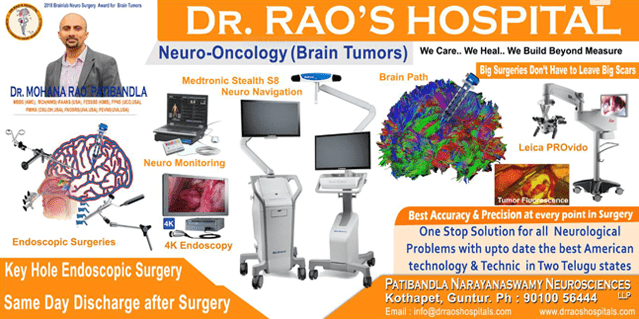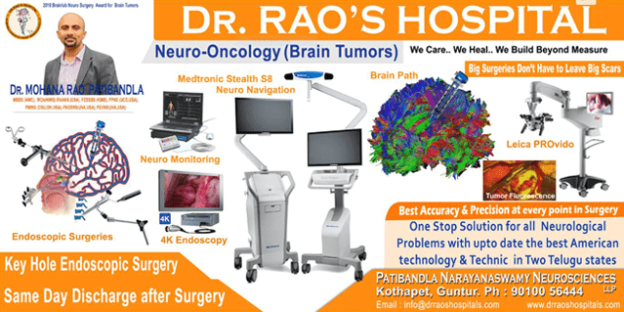The best Brain Tumor Treatment: Types, Symptoms, and Available Options
Introduction
Brain tumors are abnormal growths of cells in the brain that can be either benign (non-cancerous) or malignant (cancerous). In this blog, we will explore the different types of brain tumors, their symptoms, and the various treatment options available. Dr Raos hospital is the best comprehensive neurooncology center for the best clinical outcomes in India and is located at Guntur. Additionally, we will showcase some patient examples, including Koti Swamy with Glioblastoma multiforme (GBM), Raghava Rao with GBM, Srinivasa Rao with Anaplastic Astrocytoma, Mounika with thalamic pilocytic astrocytoma, and Veeranna with Anaplastic meningioma, all of whom were treated by Dr. Rao.
Types of Brain Tumors
- The World Health Organization (WHO) classification system categorizes brain tumors based on their histological and molecular characteristics. Here are the major types of brain tumors according to the WHO classification:
- Gliomas: Gliomas are tumors that originate from glial cells, which are supportive cells in the brain. They are the most common type of brain tumors. Gliomas are further classified into different grades based on their aggressiveness and malignancy:a. Astrocytoma: Astrocytomas arise from astrocytes, a type of glial cell. They can be low-grade (Grade I and II) or high-grade (Grade III and IV), with Grade IV being the most aggressive form known as Glioblastoma multiforme (GBM).b. Oligodendroglioma: Oligodendrogliomas develop from oligodendrocytes, another type of glial cell. They are typically slow-growing tumors and are often found in the frontal lobes.c. Ependymoma: Ependymomas originate from the ependymal cells that line the ventricles and central canal of the spinal cord. They are more common in children and can occur throughout the brain and spinal cord.
- Meningiomas: Meningiomas arise from the meninges, which are the protective membranes surrounding the brain and spinal cord. They are usually benign tumors and occur more frequently in females. Meningiomas can have different subtypes based on their characteristics.
- Schwannomas: Schwannomas, also known as acoustic neuromas, develop from Schwann cells that produce the protective covering (myelin) of nerve fibers. They commonly affect the vestibular nerve, which is responsible for balance and hearing.
- Pituitary adenomas: Pituitary adenomas are tumors that arise from the pituitary gland, a small gland at the base of the brain. They can affect hormone production and have various subtypes based on the cell type involved.
- Medulloblastomas: Medulloblastomas are highly malignant tumors that primarily affect children and originate in the cerebellum, the region responsible for balance and coordination. They are often fast-growing and can spread to other parts of the central nervous system.
- Primary Central Nervous System Lymphomas (PCNSL): PCNSLs are tumors that arise from lymphocytes, a type of white blood cell, within the brain or spinal cord. They are typically aggressive and most commonly occur in individuals with compromised immune systems.
- Craniopharyngioma: Craniopharyngiomas are rare tumors that develop near the pituitary gland and often affect children and young adults. They arise from remnants of embryonic tissue and can cause hormonal imbalances.
- Germ Cell Tumors: Germ cell tumors arise from germ cells, the cells that give rise to sperm or eggs. They can occur in the brain and other parts of the body. In the brain, they are commonly located in the pineal or suprasellar region.
- Pineal Parenchymal Tumors: Pineal parenchymal tumors are rare brain tumors that develop in the pineal gland, a small gland located deep within the brain. They can be either benign or malignant and include subtypes such as pineocytoma and pineoblastoma.
- Choroid Plexus Tumors: Choroid plexus tumors originate from the choroid plexus, which produces cerebrospinal fluid (CSF). These tumors are most commonly found in children and can cause CSF overproduction and hydrocephalus.
- Hemangioblastomas: Hemangioblastomas are tumors that arise from blood vessels in the brain and spinal cord. They can occur sporadically or as a part of a genetic condition called von Hippel-Lindau disease.
- Primary CNS Germ Cell Tumors: Primary central nervous system germ cell tumors originate from germ cells within the brain or spinal cord. They are rare and can occur in different age groups, with distinct subtypes such as germinoma and non-germinomatous germ cell tumors.
- Primary CNS Sarcomas: Primary central nervous system sarcomas are rare malignant tumors that develop from different types of connective tissues within the brain. They are highly aggressive and require prompt treatment.
- Neuroepithelial Tumors: Neuroepithelial tumors encompass a group of rare and diverse brain tumors that do not fit into other established categories. These tumors often require molecular and genetic testing for precise diagnosis and treatment planning.
It is important to note that brain tumor classification and terminology can be complex and continuously evolving as research advances. Accurate diagnosis and treatment planning should be done by specialized healthcare professionals, considering factors such as tumor location, size, grade, and molecular characteristics.
Common Symptoms of Brain Tumors
- Persistent headaches
- Seizures
- Nausea and vomiting
- Cognitive and personality changes
- Weakness or numbness in limbs
- Vision or hearing problems
- Difficulty with balance and coordination
Treatment Options
- Surgery: The primary treatment for brain tumors involves surgical removal of as much tumor tissue as possible. It aims to relieve symptoms, obtain a tissue sample for diagnosis, and reduce the tumor’s size. In some cases, complete removal may not be possible due to the tumor’s location or invasiveness.
- Radiation Therapy: Radiation therapy uses high-energy X-rays or other particles to destroy cancer cells and shrink tumors. It is often employed after surgery to target any remaining tumor cells or as a primary treatment when surgery is not feasible.
- Chemotherapy: Chemotherapy involves using drugs to kill cancer cells or prevent their growth. It may be administered orally or intravenously. Chemotherapy is typically used in combination with other treatments for brain tumors, such as surgery and radiation therapy.
- Targeted Therapy: Targeted therapy utilizes drugs that specifically target cancer cells’ molecular characteristics, inhibiting their growth and survival. These therapies are often tailored to the specific type of brain tumor and its genetic mutations.
Patient Examples with complex tumors Treated by Dr. Rao
- Koti Swamy: Diagnosed with Glioblastoma multiforme (GBM), Koti Swamy underwent surgery to remove the tumor, followed by a combination of radiation therapy and chemotherapy to target any remaining cancer cells.
- Raghava Rao: Similarly diagnosed with GBM, Raghava Rao received surgical intervention to remove the tumor, followed by radiation therapy and chemotherapy to target the remaining tumor cells.
- Srinivasa Rao: Diagnosed with Anaplastic Astrocytoma, Srinivasa Rao underwent surgical resection to remove the tumor. Following surgery, he received a combination of radiation therapy and chemotherapy to target any remaining cancer cells and prevent recurrence.
- Mounika: Mounika was diagnosed with thalamic pilocytic astrocytoma, a benign brain tumor. Due to the tumor’s location and low-grade nature, surgical resection was performed to remove the tumor and alleviate symptoms. Regular monitoring and follow-up are essential to ensure the tumor remains stable and does not recur.
- Veeranna: Veeranna was diagnosed with Anaplastic meningioma, a rare and aggressive form of meningioma. Treatment involved a combination of surgery, radiation therapy, and targeted therapy to remove the tumor, destroy any remaining cancer cells, and prevent further growth.
Dr. Rao’s Approach to Brain Tumor Treatment
- Dr. Rao, a renowned expert in brain tumor treatment, follows a comprehensive approach tailored to each patient’s specific diagnosis and needs. He emphasizes a multidisciplinary approach, collaborating with a team of specialists, including neurosurgeons, oncologists, radiologists, and pathologists. The treatment plan is based on factors such as tumor type, location, size, and the patient’s overall health.
- Dr. Rao’s treatment strategy may involve a combination of surgery, radiation therapy, chemotherapy, and targeted therapy, as deemed appropriate for each individual case. The goal is to achieve maximum tumor removal while minimizing damage to healthy brain tissue and providing the best possible outcome for the patient.
Conclusion
- Brain tumor treatment requires a personalized approach, considering the specific type of tumor, its location, and the patient’s overall health. Surgery, radiation therapy, chemotherapy, and targeted therapy are common treatment options used either individually or in combination to manage brain tumors. Patient examples, including Koti Swamy, Raghava Rao, Srinivasa Rao, Mounika, and Veeranna, highlight the diverse treatment approaches employed by Dr. Rao to address different types of brain tumors. Early detection, accurate diagnosis, and timely intervention are crucial in improving patient outcomes and quality of life.
#BrainTumorTreatment #BrainTumors #TumorTypes #Symptoms #TreatmentOptions #Neurooncology #CancerTreatment #Glioblastoma #Astrocytoma #Meningioma #PituitaryAdenoma #Medulloblastoma #BrainHealth #PatientStories #DrRao


